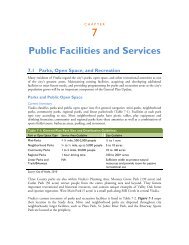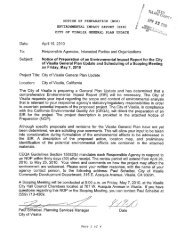General Plan Update Review Committee Draft Elements Part 2 For ...
General Plan Update Review Committee Draft Elements Part 2 For ...
General Plan Update Review Committee Draft Elements Part 2 For ...
Create successful ePaper yourself
Turn your PDF publications into a flip-book with our unique Google optimized e-Paper software.
dation, competition, or disease. The status is determined<br />
by the State Department of Fish and Game<br />
together with the State Fish and Game Commission.<br />
Endangered Species, Federal. A species which is in<br />
danger of extinction throughout all or a significant<br />
portion of its range, other than the species of the<br />
Class Insect determined to constitute a pest whose<br />
protection under the provisions of the 1973 Endangered<br />
Species Act, as amended, would present an<br />
overwhelming and overriding risk to humans. The<br />
status is determined by the US Fish and Wildlife<br />
Service and the Department of the Interior.<br />
Environmental Impact Report (EIR). A document<br />
used to evaluate the potential environmental impacts<br />
of a project, evaluate reasonable alternatives to the<br />
project, and identify mitigation measures necessary<br />
to minimize the impacts. The California Environmental<br />
Quality Act (CEQA) requires that the agency<br />
with primary responsibility over the approval of a<br />
project (the lead agency) evaluate the project’s potential<br />
impacts in an Environmental Impact Report<br />
(EIR).<br />
Environmental Justice. Environmental Justice refers<br />
to the fair treatment of all people – regardless of race,<br />
income, and religion – when implementing policies<br />
that affect housing and the environment. The federal<br />
and State government have policies that require<br />
agencies to identify and avoid placing a disproportionately<br />
large number of minority and low-income<br />
populations in certain geographical locations.<br />
Equivalent Sound Level (Leq). A single-number representation<br />
of the fluctuating sound level in decibels<br />
over a specified period of time. It is a sound-energy<br />
average of the fluctuating level.<br />
Erosion. The process by which material is removed<br />
from the earth’s surface (including weathering, dissolution,<br />
abrasion, and transportation), most commonly<br />
by wind or water.<br />
Expansive Soils. Soils which swell when they absorb<br />
water and shrink as they dry.<br />
Farmland Classification. California Department of<br />
Conservation system for categorizing farmland with<br />
respect to its potential for agricultural productivity<br />
based on soil type and other physical characteristics.<br />
Fault. A fracture in the earth’s crust forming a<br />
boundary between rock masses that have shifted.<br />
An active fault is a fault that has moved recently and<br />
which is likely to again. An inactive fault is a fault<br />
which shows no evidence of movement in recent geologic<br />
time and little potential for movement.<br />
Findings. Findings are defined as the results of an<br />
investigation, carried out by an investigating team.<br />
Floodplain. An area adjacent to a lake, stream, ocean<br />
or other body of water lying outside the ordinary<br />
banks of the water body and periodically inundated<br />
by flood flows. Often referred to as the area likely to<br />
be inundated by the 100-year flood.




